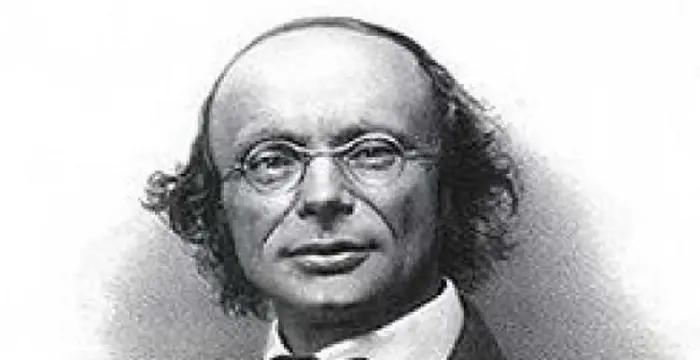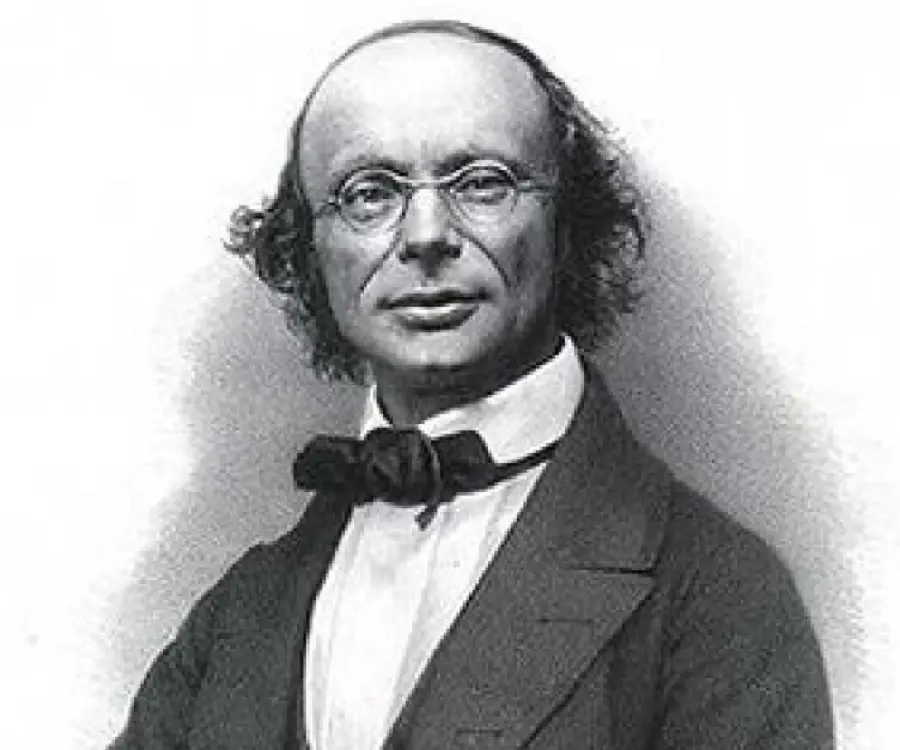
Wilhelm Weber - Physicst, Birthday and Life
Wilhelm Weber's Personal Details
Wilhelm Weber was renowned German physicst of the early 19th century
| Information | Detail |
|---|---|
| Birthday | October 24, 1804 |
| Died on | June 23, 1891 |
| Nationality | German |
| Famous | Scientists, Physicists, Physicst |
| Siblings | Eduard Friedrich Weber, Ernst Heinrich Weber |
| Known as | Wilhelm E. Weber |
| Universities |
|
| Discoveries / Inventions |
|
| Birth Place | Wittenberg, Saxony, Holy Roman Empire |
| Gender | Male |
| Father | Michael Weber. |
| Sun Sign | Scorpio |
| Born in | Wittenberg, Saxony, Holy Roman Empire |
| Famous as | Physicst |
| Died at Age | 86 |
Wilhelm Weber's photo
Who is Wilhelm Weber?
Wilhelm Eduard Weber, best remembered as the co-inventor of the first electromagnetic telegraph, was a 19th century German physicist born in Wittenberg. Later the family shifted to Halle, where he received his formal education. Starting his career as a Privatdozent at the University of Halle, he shifted to the University of Göttingen as Professor of Physics on the invitation of Carl Friedrich Gauss. There he collaborated with Gauss to develop the first practical long-distance telegraph. He lost his position when he, along with six others, protested against the King of Hanover’s move to revoke the constitution. Later, he was appointed as a Professor of Physics at the Leipzig University, but returned to Göttingen when the King was forced to retract his decisions. He devoted his later career to the study of electrodynamics and the electrical structure of matter. Collaborating with Rudolf Kohlrausch, he demonstrated that the number produced by the ratio of electrostatic to electromagnetic units matched the value of the then known speed of light. In addition, he also developed a number of devices, the most significant of them being the electrodynamometer.
// Famous Physicists
Henry Cavendish
Henry Cavendish was a theoretical chemist and physicist, renowned for discovery of hydrogen and calculation of the mass of earth. To know more about his childhood, profile, timeline and career read on
Walter Kohn
Nobel Laureate Walter Kohn was an Austrian-born American theoretical chemist and physicist. Check out this biography to know about his childhood, life, achievements, works & timeline.
Nikola Tesla
Nikola Tesla was a Serbian-American inventor, best known for his development of alternating current electrical systems. This biography of Nikola Tesla provides detailed information about his childhood, life, achievements, works & timeline.
Childhood & Early Life
Wilhelm Eduard Weber was born on 24 October 1804 in Wittenberg. His father, Michael Weber, was Professor of Theology at the University of Wittenberg. Michael had thirteen children, out of which only one daughter and four sons reached adulthood. Wilhelm was his third surviving son.
Among his brothers, the eldest became a minister. His second elder bother Ernst Heinrich became a leading anatomist and physiologist, and a professor at the University of Leipzig. The youngest brother, Eduard, also became a professor of anatomy at Leipzig.
In 1814, Prussia attacked Wittenberg. During the raid, the house the Weber family lived in was destroyed and as the Prussian army captured the city, the university, where his father was a professor, was closed down.
Therefore in 1815, the family shifted to Halle, where Michael Weber became a Professor of Theology at the University of Halle. Until now, Wilhelm had his lessons at home but now in Halle, he was enrolled at the Orphan Asylum and Grammar School.
In 1821, Wilhelm entered Francke Institute, preparing for entry into the University of Halle. At that time, he was only seventeen years old but advanced enough to join his second brother, Ernst Heinrich, in his research on the flow of liquids as well as water and sound waves.
In 1822, he entered the University of Halle, studying natural philosophy. During this period, he was strongly influenced by physicist Johann S. C. Schweigger and the mathematician Johann Friedrich Pfaff.
Concurrently, he continued to collaborate with his brother Ernst and in 1825, published the result of their experiments as ‘Wellenlehre, auf Experimente gegründet.’ It made their names familiar in the scientific circuit.
By then, he had also started working on his doctoral dissertation on reed organ pipes under Professor Schweigger. He submitted his thesis in 1826, receiving the degree in the same year.
Scholar at Halle
In 1827, Wilhelm Weber joined University of Halle as a Privatdozent. He now started writing his habilitation thesis on reed organ pipes as coupled oscillators with acoustic coupling of tongue and air cavity, submitting it in the same year.
In 1828, he became an Extraordinary Professor of natural philosophy at Halle. Later in September, he accompanied Ernst to Berlin, where the brothers attended the 7th meeting of the Gesellschaft Deutscher Naturforscher und Arzte.
Here Wilhelm Weber read a paper on organ pipes. It greatly impressed scholars like Alexander von Humboldt, who was the organizer of the meet, and Carl Friedrich Gauss, a professor at the University of Göttingen, who was at that time interested in geomagnetism.
Gauss was quick to recognize Weber’s potential and realized that the young man would make a great co-worker. Unfortunately, at that time, there was no position available for Weber at Göttingen and so he remained at Halle and published a series of papers on reed organ pipes.
Professor of Physics at Gottingen
In early 1831, upon the death of Tobias Mayer Jr., a vacancy was created at Göttingen and Weber was offered the position. In April, he joined the University of Göttingen as the Professor of Physics.
Here, he excelled in teaching, illustrating his lectures with experiments. Soon he realized that the students would benefit more if they could perform those experiments themselves. Therefore, he opened his laboratory for the use of his students.
Concurrently, for next six years, he worked closely with Gauss, producing many important papers. The first of them, published in late 1832, was titled ‘Intensitas vis magneticae terrestris ad mensuram absolutam revocata.’ In it, they introduced the absolute units of measurement of magnetism.
The success of this project depended largely on the sensitive magnetometers and other magnetic instruments developed by Weber. Therefore, although the paper was read by Gauss, Weber’s contributions to this work were highly appreciated by the scientific faculty.
In 1833, Gauss and Weber, with the support of Alexander von Humboldt, initiated Göttingen Magnetische Verein, consisting of a network of magnetic observatories across the world. Their goal was to measure the fluctuations of the earth's magnetic field in coordinated form. To get accurate readings, Weber also devised many instruments.
Also in 1833, to facilitate simultaneous magnetic observations, the two scientists set up a 9000 feet long telegraph line between the physics laboratory and the astronomical observatory. Initially it was battery-operated, but in 1834, they replaced the battery with electric current.
The Magnetische Verein they had initiated in 1833 became functional in 1836, remaining in operation until 1842. From 1837 to 1843, it published several papers, initially written mainly by Gauss and Weber. Later however, reports from various centers began to be published.
Concurrently, Wilhelm Weber also collaborated with his younger brother Eduard on physiology and physics of human locomotion. Titled, ‘Mechanik der menschlichen Gehwerkzeuge’, the paper was published in 1836. Unfortunately, the very next year, he became involved in a political controversy and lost his position.
Loss of Position
In 1837, on becoming the King of Hanover, Ernst August revoked the liberal constitution of 1833. Wilhelm Weber, along with six others, sent a letter of protest to the King. They also refused to take oath to the new King.
In retaliation, the King dismissed all seven—later known as ‘Göttinger Sieben’—from the positions they held. Weber’s friends tried to have him in reinstituted; however, for that he was required to write a public retraction, which Weber refused to do.
Though unemployed, Wilhelm Weber continued to work for Göttingen Magnetische Verein and from March 1838 to August 1838, he travelled first to Berlin and then to London, trying to extend the network. Later, he went to Paris, where he met many distinguished scientists.
In Leipzig
Finally in 1843, when Professor G. T. Fechner of the University of Leipzig took early retirement due to partial blindness, Weber was appointed to his Chair and became Professor of Physics at Leipzig. At that time, both his brothers were employed at the same university.
He remained at Leipzig till 1849. In 1832, while he was a professor of Göttingen, he had started working on electrical force. He now continued with the work and formulated his law of electrical force. In 1846, he published the first of his ‘Elektrodynamische Massenbestimmungen.’
Return to Gottingen
The year 1848 saw a great uprising in Hanover and the king was forced to reconsider many of his decisions which led to the reinstitution of Wilhelm Weber at the University of Göttingen. Accordingly, Weber rejoined his old institution in 1849.
At that time, the position of Professor of Physics was being held by J.B. Listing. At Weber’s request, Listing retained the chair and Weber was appointed the Director of the Astronomical Observatory. However, he still continued to work in the field of electricity and magnetism.
Sometime in 1854, Weber started collaboration with Rudolf Hermann Arndt Kohlrausch, then an Associate Professor at the University of Marburg. In 1856, they demonstrated that the number produced by the ratio of electrostatic to electromagnetic units matched the value of the then known speed of light.
Subsequently, Weber began to take interest in electrodynamics and the electrical structure of matter. His closest collaborator during the later period of his career was astrophysicist J. K. F. Zöllner of the University of Leipzig. Together they worked on electrical conductivity.
Weber officially retired from the University of Göttingen sometime in the 1870s. His work was taken up by his assistant and successor, Eduard Riecke, who in his later years developed the electron theory of metals, basing it on Weber’s ideas.
Later when J. K. F. Zöllner passed away in 1882, Weber took up his ideas and began to work on the interaction of atoms of the two kinds of electricity. The result of his work was left in the manuscript form in his last work, ‘Elektrodynamische Maassbestimmungen’.
Major Works
Wilhelm Weber’s theoretical contributions consist of eight long works, titled ‘Elektrodynamische Maassbestimmungen’. Seven of these works had been published from 1846 to 1878 and eighth one, left in manuscript form, was published posthumously.
However, he is best remembered for the work he carried on with Rudolph Kohlrausch on the ratio between the electrodynamic and electrostatic units of charge. Published as a paper in 1856, the work proved crucial to the development of Maxwell’s theory that light is an electromagnetic wave. Moreover, the first use of "c" for the speed of light appears in this paper.
He is remembered for his work on electromagnetic telegraph as well. In 1833, he collaborated with Gauss to develop one of the first long-range telegraphs that were also practical.
Weber had also worked towards the development of many instruments and the most significant of them was his work on electrodynamometer. In 1848, he laid down its basic principle, which was later used by Werner von Siemens to develop the actual instrument.
Awards & Achievements
In 1855 Weber was elected a foreign member of the Royal Swedish Academy of Sciences.
In 1859, he was honored with the Copley Medal by the Royal Society, London "for the investigations contained in his Maasbestimmungen and other researches in electricity, magnetism, and acoustics."
In 1879, he received the Matteucci Medal, an Italian award for physicists from the Italian Society of Sciences.
Personal Life & Legacy
Wilhelm Weber never got married. His household was mainly managed by his sister and later by his niece. He was a simple man and loved hiking. Much of his travels were done on foot.
On 23 June 1891, Weber died peacefully in his garden in Göttingen. He was then eighty-six years old. He was buried at old Stadtfriedhof (City Cemetery) in Göttingen.
The ‘weber’, the SI unit of magnetic flux, symbolized by Wb, has been named in his honor.
Trivia
Apart from Weber, the other members of ‘Göttinger Sieben’ were F. E. Dahlmann, W. E. Albrecht, Jakob Grimm, Wilhelm Grimm, G. Gervinus, and G. H. von Ewald. Among them, Jacob and Wielham Grimm were the famous fairy tale and folk tale writers, known to the world as Brothers Grimm.
// Famous Scientists
Juliane Koepcke
Juliane Koepcke is a German-Peruvian biologist, who was the lone survivor among the 92 passengers and crew of the ill-fated LANSA Flight 508 that crashed in the Peruvian rainforest on 24 December 1971. Know more about her life in this biography.
Henry Cavendish
Henry Cavendish was a theoretical chemist and physicist, renowned for discovery of hydrogen and calculation of the mass of earth. To know more about his childhood, profile, timeline and career read on
Konstantin Tsiolkovsky
Konstantin Tsiolkovsky was a Russian rocket scientist and a pioneer of astronautics. This biography provides detailed information about his childhood, family, personal life, career, achievements, etc.
Wilhelm Weber's awards
| Year | Name | Award |
|---|---|---|
Other | ||
| 0 | 1859 - Copley Medal | |
| 0 | 1879 - Matteucci Medal | |
Wilhelm Weber biography timelines
- // 24th Oct 1804Wilhelm Eduard Weber was born on 24 October 1804 in Wittenberg. His father, Michael Weber, was Professor of Theology at the University of Wittenberg. Michael had thirteen children, out of which only one daughter and four sons reached adulthood. Wilhelm was his third surviving son.
- // 1814In 1814, Prussia attacked Wittenberg. During the raid, the house the Weber family lived in was destroyed and as the Prussian army captured the city, the university, where his father was a professor, was closed down.
- // 1815Therefore in 1815, the family shifted to Halle, where Michael Weber became a Professor of Theology at the University of Halle. Until now, Wilhelm had his lessons at home but now in Halle, he was enrolled at the Orphan Asylum and Grammar School.
- // 1821In 1821, Wilhelm entered Francke Institute, preparing for entry into the University of Halle. At that time, he was only seventeen years old but advanced enough to join his second brother, Ernst Heinrich, in his research on the flow of liquids as well as water and sound waves.
- // 1822In 1822, he entered the University of Halle, studying natural philosophy. During this period, he was strongly influenced by physicist Johann S. C. Schweigger and the mathematician Johann Friedrich Pfaff.
- // 1826By then, he had also started working on his doctoral dissertation on reed organ pipes under Professor Schweigger. He submitted his thesis in 1826, receiving the degree in the same year.
- // 1827In 1827, Wilhelm Weber joined University of Halle as a Privatdozent. He now started writing his habilitation thesis on reed organ pipes as coupled oscillators with acoustic coupling of tongue and air cavity, submitting it in the same year.
- // 1828In 1828, he became an Extraordinary Professor of natural philosophy at Halle. Later in September, he accompanied Ernst to Berlin, where the brothers attended the 7th meeting of the Gesellschaft Deutscher Naturforscher und Arzte.
- // 1831In early 1831, upon the death of Tobias Mayer Jr., a vacancy was created at Göttingen and Weber was offered the position. In April, he joined the University of Göttingen as the Professor of Physics.
- // 1832Concurrently, for next six years, he worked closely with Gauss, producing many important papers. The first of them, published in late 1832, was titled ‘Intensitas vis magneticae terrestris ad mensuram absolutam revocata.’ In it, they introduced the absolute units of measurement of magnetism.
- // 1832 To 1849He remained at Leipzig till 1849. In 1832, while he was a professor of Göttingen, he had started working on electrical force. He now continued with the work and formulated his law of electrical force. In 1846, he published the first of his ‘Elektrodynamische Massenbestimmungen.’
- // 1833In 1833, Gauss and Weber, with the support of Alexander von Humboldt, initiated Göttingen Magnetische Verein, consisting of a network of magnetic observatories across the world. Their goal was to measure the fluctuations of the earth's magnetic field in coordinated form. To get accurate readings, Weber also devised many instruments.
- // 1833Also in 1833, to facilitate simultaneous magnetic observations, the two scientists set up a 9000 feet long telegraph line between the physics laboratory and the astronomical observatory. Initially it was battery-operated, but in 1834, they replaced the battery with electric current.
- // 1833 To 1837In 1837, on becoming the King of Hanover, Ernst August revoked the liberal constitution of 1833. Wilhelm Weber, along with six others, sent a letter of protest to the King. They also refused to take oath to the new King.
- // 1833He is remembered for his work on electromagnetic telegraph as well. In 1833, he collaborated with Gauss to develop one of the first long-range telegraphs that were also practical.
- // 1837 To 1842The Magnetische Verein they had initiated in 1833 became functional in 1836, remaining in operation until 1842. From 1837 to 1843, it published several papers, initially written mainly by Gauss and Weber. Later however, reports from various centers began to be published.
- // 1838Though unemployed, Wilhelm Weber continued to work for Göttingen Magnetische Verein and from March 1838 to August 1838, he travelled first to Berlin and then to London, trying to extend the network. Later, he went to Paris, where he met many distinguished scientists.
- // 1843Finally in 1843, when Professor G. T. Fechner of the University of Leipzig took early retirement due to partial blindness, Weber was appointed to his Chair and became Professor of Physics at Leipzig. At that time, both his brothers were employed at the same university.
- // 1846 To 1878Wilhelm Weber’s theoretical contributions consist of eight long works, titled ‘Elektrodynamische Maassbestimmungen’. Seven of these works had been published from 1846 to 1878 and eighth one, left in manuscript form, was published posthumously.
- // 1848The year 1848 saw a great uprising in Hanover and the king was forced to reconsider many of his decisions which led to the reinstitution of Wilhelm Weber at the University of Göttingen. Accordingly, Weber rejoined his old institution in 1849.
- // 1848Weber had also worked towards the development of many instruments and the most significant of them was his work on electrodynamometer. In 1848, he laid down its basic principle, which was later used by Werner von Siemens to develop the actual instrument.
- // 1854Sometime in 1854, Weber started collaboration with Rudolf Hermann Arndt Kohlrausch, then an Associate Professor at the University of Marburg. In 1856, they demonstrated that the number produced by the ratio of electrostatic to electromagnetic units matched the value of the then known speed of light.
- // 1855In 1855 Weber was elected a foreign member of the Royal Swedish Academy of Sciences.
- // 1856However, he is best remembered for the work he carried on with Rudolph Kohlrausch on the ratio between the electrodynamic and electrostatic units of charge. Published as a paper in 1856, the work proved crucial to the development of Maxwell’s theory that light is an electromagnetic wave. Moreover, the first use of "c" for the speed of light appears in this paper.
- // 1859In 1859, he was honored with the Copley Medal by the Royal Society, London "for the investigations contained in his Maasbestimmungen and other researches in electricity, magnetism, and acoustics."
- // 1879In 1879, he received the Matteucci Medal, an Italian award for physicists from the Italian Society of Sciences.
- // 23rd Jun 1891On 23 June 1891, Weber died peacefully in his garden in Göttingen. He was then eighty-six years old. He was buried at old Stadtfriedhof (City Cemetery) in Göttingen.
// Famous Scorpio Celebrities peoples
Teddy Zois
Teddy Zois is an American Musical.ly star and social media personality. Let’s have a look at his family and personal life including age, date of birth, net worth, and fun facts.
Kyla Cole
Kyla Cole is a Slovak glamour model and former television presenter. This biography profiles her childhood, life, modeling career, achievements and timeline.
Dominic Tracy
Dominic Tracy is an American YouTube Star. Let’s take a look at his family & personal life including age, date of birth, girlfriends, net worth, and fun facts.
Paige Mackenzie Hyland
Paige Mackenzie Hyland is an American dancer, fashion model and social media personality. Let’s take a look at her family & personal life including age, birthday, net worth, boyfriends, and fun facts.
Devin Gordon
All about American Pop singer and internet celebrity Devin Gordon, including his age, birthday, family life, girlfriends, net worth, and some fun facts.
Cody Ko
Cody Ko is a Canadian Vine sensation and YouTube personality. Check out this biography to know about his childhood, family life, achievements and fun facts about him.
Wilhelm Weber's FAQ
What is Wilhelm Weber birthday?
Wilhelm Weber was born at 1804-10-24
When was Wilhelm Weber died?
Wilhelm Weber was died at 1891-06-23
Where was Wilhelm Weber died?
Wilhelm Weber was died in Göttingen
Which age was Wilhelm Weber died?
Wilhelm Weber was died at age 86
Where is Wilhelm Weber's birth place?
Wilhelm Weber was born in Wittenberg, Saxony, Holy Roman Empire
What is Wilhelm Weber nationalities?
Wilhelm Weber's nationalities is German
Who is Wilhelm Weber siblings?
Wilhelm Weber's siblings is Eduard Friedrich Weber, Ernst Heinrich Weber
What was Wilhelm Weber universities?
Wilhelm Weber studied at Martin Luther University of Halle-Wittenberg, Georg-August University of Göttingen
What is Wilhelm Weber's inventions/discoveries?
Electromagnetic Telegraph was invented (or discovered) by Wilhelm Weber
Who is Wilhelm Weber's father?
Wilhelm Weber's father is Michael Weber.
What is Wilhelm Weber's sun sign?
Wilhelm Weber is Scorpio
How famous is Wilhelm Weber?
Wilhelm Weber is famouse as Physicst











